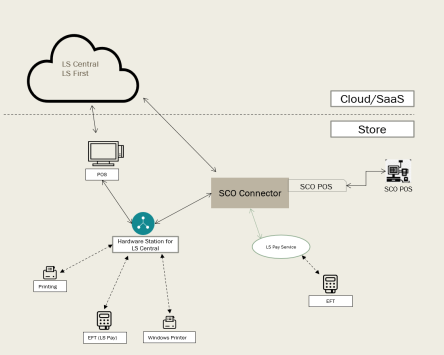The Self-Checkout Connector (SCO) is a bridge between LS Central and self-checkout (SCO) devices from different hardware manufacturers. It enables seamless communication through web services to support core checkout operations such as item scanning, transaction processing, tender handling, and device workflows.
The Connector communicates with LS Central web services and implements the necessary mapping between LS Central and the specific SCO hardware device information, data, and functionality. It is not used when the LS Central POS itself is running as the user interface on a self-service checkout terminal.
The SCO Connector is flexible and can be configured to run at different levels within the store. For example, it can run centrally on a store server and connect to multiple SCO devices while communicating with LS Central in the cloud. Alternatively, it can be deployed directly on the SCO device, where all communication takes place within the same terminal.
This documentation outlines the required steps to prepare and configure LS Central for integration with the SCO Connector. It covers both the technical and functional prerequisites, including authentication methods, configuration packages, profile assignments, and tender type mappings. You will be guided step by step—from preparing your Business Central environment to completing the SCO installation—to ensure a smooth deployment and reliable operation.

Help articles for the SCO Connector are grouped in a few sections that you access by clicking the links below:
| To | See |
|---|---|
| Review system requirements before installing SCO. | Prerequisites |
| Configure LS Central to work with Self-Checkout Connector. | LS Central Configuration Steps |
| Set up and manage the Self-Checkout Connector card. | SCO Connector Configuration |
| Understand and configure available feature flags | Feature Flags |
| Monitor and manage SCO while it is running. | SCO Service Administration portal |
| Check supported POS device types and learn about custom implementations. | Supported Device Types and Custom Implementations |